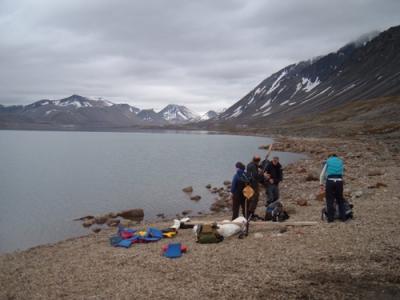Saturday, July, 21. We just got out internet connection at the base camp at Isfjord Radio Station. It took some doing, but thanks to the perserverence and tech skills of Steve Roof, it came to fruition. It will take me a day or two too catch up, and I appologize for the delay. Life at 78 degrees north latitiude is a bit different than just swinging by your local internet cafe or call to verizoon for internet access!
We made the trip to Kapp Linne Saturday morning. The ride from Longyearbyen to Isfjord radio station was beautiful! The zodiac boats were loaded down with gear and researchers and we made good time (about 90 minutes) as the water was not to choppy. As you can see from the pictures we all were in our survival suites because an unfortante fall into this water without one would be quickly fatal. The trip includes about 15 people from three different research teams. There is the American team of Al, Mike, Steve, Patti ( Mount Holyoke student) and Meagan (Bates student), a Japenese team and a Norweigan team headed by Hannah, who is also an admisitrator at UNIS (a renowned Norweigan university branch specializing in polar studies). Everyone was excited and in good cheer. I am very impressed with the professionalism and passion these researchers have for their work and for the Arctic. I am also pleased to report that they all have a terrific sense of humor that makes being so far from home a bit easier.
When we arrived at Isfjord we had a delicious dinner of Reindeer stew served by our wonderful cook, Erik. After some orientation to our new base camp we headed right out to our study site at Lake Linne about 3 miles over the Arctic tundra. A beautiful walk, but one must always stay alert for polar bears as they are said to cross vast distances from the south west to occasionally visit the Isfjord and Kapp Linne region. We assembled a zodiac boat at Lake Linne that had previously been dropped by a helicopter and got on the water. We used GPS technology to locate several moorings that held sediments traps at the far south end of the lake. These were "flagged" with floaties for better visiabiltiy for retrival the next day (Monday). Next, Steve Roof and I hiked up to a ledge above the lake to service the "plume cam." This remote camera set in a box and powered by a marine batery and supplemented by a solar panel, takes a picture every 3 hours of the inlet at the south end to capture images of sediment influx to the lake. It is hoped that by learning when the sediment pulses enter the lake, Al, Mike and Steve can determine very tight times where sediment enters the lake and also the rate of ice melt from the glacier that feeds the stream (much more on this later). This, along with the actual collection of sediment previously suspended in the water column, measurements of snow/ice melt on the glacier and below it along the river, temperature readings of atmosphere and water, measuremnts of light reflection from snow (albedo effect) and exposed ground, Al, Mike and Steve can get a step or two closer in unraveling the complicated dynamnics of climate patterns and change in these patterns within this region over time.



